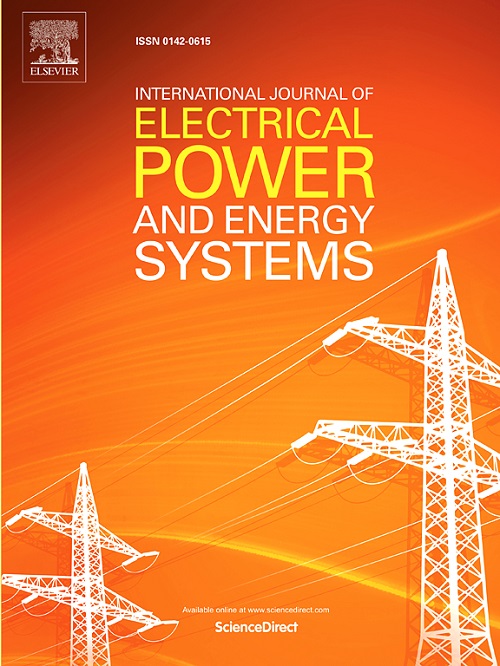部署具有成本效益的 WAMS 基础设施,增强网络物理弹性
IF 5
2区 工程技术
Q1 ENGINEERING, ELECTRICAL & ELECTRONIC
International Journal of Electrical Power & Energy Systems
Pub Date : 2024-10-29
DOI:10.1016/j.ijepes.2024.110305
引用次数: 0
摘要
本文为广域测量系统(WAMS)基础设施的部署提出了一种新的组合技术,以增强网络物理弹性。通过使用通用代数建模语言(GAMS)平台解决整数线性规划(ILP)的新方法,确保了面向变电站的完整系统可观测性的相量测量单元(PMU)和相量数据集中器(PDC)的最佳部署。应用多属性效用技术(MAUT)制定了至关重要的位置向量,指导 PDC 部署位置的选择。然而,仅在整个网络中优化 PMU 和 PDC 的分布并不能满足这些复杂而昂贵的测量和监控设备的目的;相反,还需要确保该设备的快速和精确测量能够通过最短通信路径通过 PDC 到达发电和输电运营商。因此,我们提出了一种最短跨越路径算法,用于最小化 WAMS 单元之间的通信路径。在系统中存在网络物理攻击受损设备的情况下,对提出的方法进行了扩展。在 OMNeT++ 中对经验 WAMS 元件通信网络进行了建模和执行。通过考虑 WAMS 元件的一些实际成本,计算出了总体成本。在标准 IEEE 测试用例(IEEE 14 总线、30 总线和 118 总线系统)中检验了所提技术的有效性,并进行了事后分析。最后,为了测试建议方法的有效性,将结果与一些成熟的方法进行了比较。保留所有权利。本文章由计算机程序翻译,如有差异,请以英文原文为准。
Cost-effective WAMS infrastructure deployment for cyber-physical resiliency enhancement
This paper proposes a new combinatorial technique for Wide Area Measurement System (WAMS) infrastructure deployment for cyber physical resiliency enhancement. A meaningful optimal placement of Phasor Measurement Unit (PMU) for substation oriented complete system observability and Phasor Data concentrator (PDC) have been ensured proposing new method for solving Integer Linear Programming (ILP) using General Algebraic Modelling Language (GAMS) platform. Critically important location vector have been formulated applying Multi Attribute Utility Technique (MAUT), which directs the PDC deployment location selection. However, only the optimal distribution of PMUs and PDCs throughout the network does not satisfy the purpose of these sophisticated yet costly measuring and monitoring devices; rather it is required to be ensured that the fast and precise measurements from this device can be reached to the generation and transmission operators via PDC through the shortest communication path. Hence, a shortest spanning path algorithm has been proposed for the minimization of the communication path among the WAMS elements. The proposed method has been extended while the cyber physical attack compromised device is present in the system. The empirical WAMS elements communication network has been modelled and executed in OMNeT++. The overall cost is calculated by considering some practical cost of the WAMS elements. The efficacy of the proposed technique is checked applying by it on standard IEEE test cases- IEEE 14 bus, 30 bus, and 118-bus system, and represented with post mortem analysis. Finally, to test the effectiveness of the proposed method the results have been compared to some well-established methods.
© 2017 Elsevier Inc. All rights reserved.
求助全文
通过发布文献求助,成功后即可免费获取论文全文。
去求助
来源期刊
CiteScore
12.10
自引率
17.30%
发文量
1022
审稿时长
51 days
期刊介绍:
The journal covers theoretical developments in electrical power and energy systems and their applications. The coverage embraces: generation and network planning; reliability; long and short term operation; expert systems; neural networks; object oriented systems; system control centres; database and information systems; stock and parameter estimation; system security and adequacy; network theory, modelling and computation; small and large system dynamics; dynamic model identification; on-line control including load and switching control; protection; distribution systems; energy economics; impact of non-conventional systems; and man-machine interfaces.
As well as original research papers, the journal publishes short contributions, book reviews and conference reports. All papers are peer-reviewed by at least two referees.

 求助内容:
求助内容: 应助结果提醒方式:
应助结果提醒方式:


